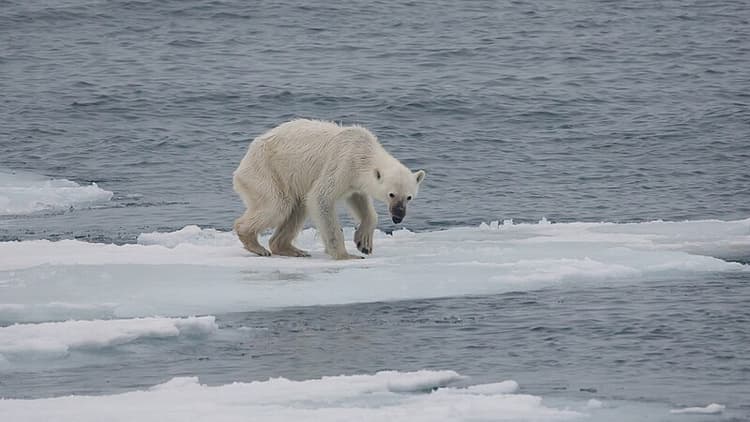Global Climate Change
Liam Thomas
5 min read
Listen to this study note
Study Guide Overview
This study guide covers past climates using ice core analysis, natural heat distribution via atmospheric and oceanic circulation, and future temperature projections based on computer models. It emphasizes the importance of positive feedback loops in polar regions, specifically melting ice and snow, habitat loss, and rising sea levels. The guide also includes practice questions and exam tips.
#🌡️ Climate Cycles: Heating Up & Cooling Down 🧊
#🕰️ Past Climates: Ice Core Secrets
Earth's climate has always been a rollercoaster, with big swings between warm and cold periods. How do we know? Scientists are like detectives, using ice cores to uncover the past! These cores, drilled from places like Antarctica, hold tiny bubbles of ancient air. 🌬️
- Ice Core Analysis:
- Snow compacts into ice, trapping atmospheric gases.
- Bubbles reveal past CO2, methane, and pollutant levels.
- Deeper ice = older samples = historical climate data.
High CO2 levels in ice cores correlate with warmer climates. It's like a historical thermometer! 🌡️
#🔄 Natural Heat Distribution
Earth doesn't heat evenly. The equator gets more sun than the poles. To balance things out, we have:
- Atmospheric & Oceanic Circulation:
- Warm air and water move from the equator towards the poles.
- Cool air and water return to the equator.
- Think of it like a global conveyor belt for heat!
Climate change can disrupt these natural circulation patterns, leading to unpredictable weather. 🌪️
#🌡️ Future Temperatures: Computer Models
Scientists use computer models to predict future warming based on different CO2 emission scenarios. 📈
- Projected Warming:
- Estimates suggest a potential 1.8°C temperature increase by 2100. * This might not sound like much, but it can have HUGE impacts!
#🧊 The Poles and Positive Feedback Loops
The poles are like the canary in the coal mine for climate change. What happens there has a ripple effect globally.
- Melting Ice & Snow:
- As temperatures rise, ice and snow melt.
- Less reflective surfaces mean more solar radiation is absorbed.
- This leads to even faster warming—a positive feedback loop. 🔄
Think of it like this: Melting ice is like turning down the Earth's thermostat, making it even warmer! 🌡️
-
Habitat Loss:
- Melting ice destroys habitats for animals like seals, walruses, and polar bears. 🐻❄️
- Thawing permafrost releases methane, further accelerating climate change.
-
Rising Sea Levels:
- Melting ice increases ocean volume, causing flooding in coastal areas. 🌊
- Marine ecosystems are disrupted—some habitats are flooded, others are pushed deeper.

#Image Courtesy of Wikimedia
Remember the positive feedback loop! Melting ice leads to more warming, which leads to more melting. It's a cycle!
#Final Exam Focus
- Key Topics:
- Ice core data and its significance
- Natural heat distribution mechanisms
- Positive feedback loops (especially at the poles)
- Impacts of melting ice: habitat loss, sea-level rise, methane release
- Common Question Types:
- Analyzing graphs and data related to CO2 levels and temperature
- Explaining the mechanisms behind positive feedback loops
- Evaluating the impacts of climate change on ecosystems and human populations
- Last-Minute Tips:
- Stay calm and focused. You've got this! 💪
- Read questions carefully and note key terms.
- Manage your time wisely. Don't get stuck on one question.
- Use diagrams and examples to support your answers.
Don't confuse positive and negative feedback loops. Positive loops amplify change, while negative loops reduce it.
Practice Question
Multiple Choice Questions
-
Which of the following best describes the relationship between atmospheric CO2 concentration and global temperature, as revealed by ice core data? (A) As CO2 concentration increases, global temperature decreases. (B) As CO2 concentration decreases, global temperature increases. (C) There is no significant relationship between CO2 concentration and global temperature. (D) As CO2 concentration increases, global temperature increases.
-
Which of the following is an example of a positive feedback loop related to climate change? (A) Increased plant growth due to higher CO2 levels, which then absorbs more CO2. (B) Increased cloud cover, which reflects more solar radiation back into space. (C) Melting of arctic ice, which decreases albedo and leads to more solar radiation absorption. (D) Increased ocean absorption of CO2, which reduces atmospheric CO2 levels.
Free Response Question
Climate change is significantly impacting polar regions. Describe the positive feedback loop associated with melting sea ice, and explain two consequences of this melting on the environment and/or human populations.
Scoring Breakdown:
- Positive Feedback Loop (2 points):
- 1 point for identifying that melting ice reduces albedo (reflectivity).
- 1 point for explaining that reduced albedo leads to increased absorption of solar radiation, which causes further warming and melting.
- Consequence 1 (2 points):
- 1 point for identifying a consequence (e.g., habitat loss for polar bears).
- 1 point for explaining how the melting ice leads to that consequence.
- Consequence 2 (2 points):
- 1 point for identifying a second consequence (e.g., sea-level rise).
- 1 point for explaining how the melting ice leads to that consequence.
Continue your learning journey

How are we doing?
Give us your feedback and let us know how we can improve





